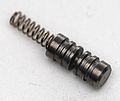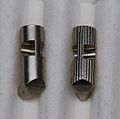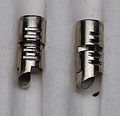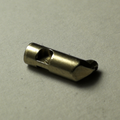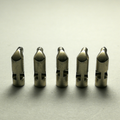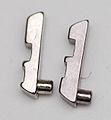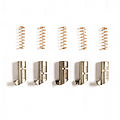Side pin: Difference between revisions
m (→Side pin: replace feature image (IKON WSW)) |
m (changed ASSA Twin Combi image to *finger* pin, because rotates) |
||
| Line 15: | Line 15: | ||
<div align="center"><gallery> | <div align="center"><gallery> | ||
File:ASSA_Twin_sidebar_pin.jpg|Side pin from the [[ASSA Twin 6000]] | File:ASSA_Twin_sidebar_pin.jpg|Side pin from the [[ASSA Twin 6000]] | ||
File:ASSA_Twin_Combi_sidebar_pins_detail.jpg| | File:ASSA_Twin_Combi_sidebar_pins_detail.jpg|Finger pin from the [[ASSA Twin Combi]] | ||
File:ASSA_Twin_V10_sidebar_pins.jpg|Side pin from the [[ASSA Twin V-10]] | File:ASSA_Twin_V10_sidebar_pins.jpg|Side pin from the [[ASSA Twin V-10]] | ||
File:Schlage_Everest_sidepin.jpg|Side pin from the [[Schlage Everest]] lock | File:Schlage_Everest_sidepin.jpg|Side pin from the [[Schlage Everest]] lock | ||
Revision as of 21:26, 31 December 2022
Side pin
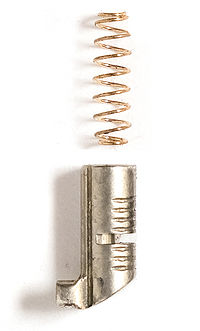
A side pin (or finger pin) is an active locking component used in many locks. Side pins are widely used on high-security locks to provide a secondary locking mechanism, enhance key control, and increase the number of available differs for a keying system. Individual side pins are often used in cylinder-based locks to prevent rotation of the plug until the proper key is used. Side pins that are not spring biased are typically referred to as sliders. Finger pins are side pins that must be lifted and rotated to the correct position before the sidebar can retract.
Many sidebar locks use side pins in some way. Keys for locks that use side pins or sidebars often have a secondary bitting surface to interact with side pins.
The Schlage Everest is one of the most notable examples of a lock that uses a single side pin.
Gallery
Side pin from the ASSA Twin 6000
Finger pin from the ASSA Twin Combi
Side pin from the ASSA Twin V-10
Side pin from the Schlage Everest lock
Finger pin from a Schlage Everest Primus XP
Finger pins from a Schlage Everest Primus XP
Side pins from the Scorpion CX-5
Side pin from the IKON WSW
Side pins & springs from the IKON WSW
See also
| This article is a stub. You can help Lockwiki by expanding it. |
